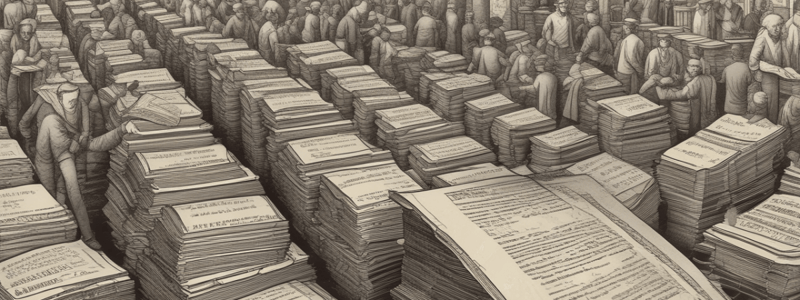Podcast
Questions and Answers
What was the primary driver for records management in the United States in the Twentieth Century?
What was the primary driver for records management in the United States in the Twentieth Century?
- Private companies
- State governments
- Non-profit organizations
- The federal government (correct)
Who signed the legislation creating the National Archives in 1934?
Who signed the legislation creating the National Archives in 1934?
- President Franklin D. Roosevelt (correct)
- Robert D.W. Connor
- Congress
- Emmett Leahy
What was Emmett Leahy's first assignment at the National Archives?
What was Emmett Leahy's first assignment at the National Archives?
- To develop a records lifecycle model
- To destroy records without permanent value
- To establish a records management program
- To form a committee of examiners to analyze records (correct)
What was the main reason for the complexity of the records problem faced by the National Archives in 1937?
What was the main reason for the complexity of the records problem faced by the National Archives in 1937?
What was the purpose of the records lifecycle model developed by Emmett Leahy?
What was the purpose of the records lifecycle model developed by Emmett Leahy?
What type of records is the records lifecycle model in Figure 1.2 best suited for?
What type of records is the records lifecycle model in Figure 1.2 best suited for?
Why did President Franklin D. Roosevelt install a recording machine in the Oval Office in 1940?
Why did President Franklin D. Roosevelt install a recording machine in the Oval Office in 1940?
What was the connection between the recording machine and President Roosevelt's telephone?
What was the connection between the recording machine and President Roosevelt's telephone?
Where do digital copies of the original recordings of FDR's radio addresses reside?
Where do digital copies of the original recordings of FDR's radio addresses reside?
What was the purpose of the Records Disposal Act of 1943?
What was the purpose of the Records Disposal Act of 1943?
What was established in 1950 to preserve records of permanent historical value?
What was established in 1950 to preserve records of permanent historical value?
Who was central to the emergence of the Commercial Records Center (CRC) industry?
Who was central to the emergence of the Commercial Records Center (CRC) industry?
What incident prompted the U.S. Congress to pass the Presidential Records Act (PRA) in 1978?
What incident prompted the U.S. Congress to pass the Presidential Records Act (PRA) in 1978?
What was the purpose of President John F. Kennedy's secret recording network?
What was the purpose of President John F. Kennedy's secret recording network?
What was the name of President Nixon's secretary who tried to assume blame for an 18-minute gap in the tapes?
What was the name of President Nixon's secretary who tried to assume blame for an 18-minute gap in the tapes?
What was the name of the facility dedicated in 1994 that holds primarily government records of the 20th century?
What was the name of the facility dedicated in 1994 that holds primarily government records of the 20th century?
What were Lt. Col. Oliver North's 'PROFS notes'?
What were Lt. Col. Oliver North's 'PROFS notes'?
What was the main purpose of the Federal Records Act of 1950?
What was the main purpose of the Federal Records Act of 1950?
What was the outcome of the 'PROFS case'?
What was the outcome of the 'PROFS case'?
What happened to White House email after 1994?
What happened to White House email after 1994?
What was the consequence of President Trump taking over 30 boxes of presidential records to his residence in Mar-A-Lago?
What was the consequence of President Trump taking over 30 boxes of presidential records to his residence in Mar-A-Lago?
What did President Biden's personal lawyers find in his possession in November 2022 and January 2023?
What did President Biden's personal lawyers find in his possession in November 2022 and January 2023?
What was the outcome of the investigation into President Biden's handling of classified records?
What was the outcome of the investigation into President Biden's handling of classified records?
Where were classified materials recovered from in the investigation into President Biden?
Where were classified materials recovered from in the investigation into President Biden?
Why did the committee decline to prosecute President Biden?
Why did the committee decline to prosecute President Biden?
What is the significance of the Iran-Contra records on NSC backup tapes?
What is the significance of the Iran-Contra records on NSC backup tapes?
Flashcards are hidden until you start studying
Study Notes
Recordkeeping in the United States in the Twentieth Century
- In 1934, Congress established the National Archives to centralize federal recordkeeping, and President Franklin D. Roosevelt signed legislation creating the National Archives.
- Robert D.W. Connor was appointed as the first Archivist of the United States.
- In 1935, Emmett Leahy joined the National Archives and formed a committee to analyze records and decide whether to destroy or dispose of them.
- By 1937, the committee realized the enormity of the records problem due to lack of conformity in procedures, growth in document volume, and duplicate records across agencies.
- The National Archives initiated a records management program to segregate temporary and archival records, with a records lifecycle model developed by Leahy.
Records Management Development
- The Records Disposal Act of 1943 defined records and authorized the National Archives Council to develop procedures for disposing of unneeded records and reproducing permanent records on microfilm.
- The Act was amended in 1945 to include the government-wide General Schedule (GS), allowing for systematic disposal of government records.
- In 1950, the Federal Records Act codified records management policies and practices, establishing the National Archives and Records Administration (NARA) to preserve records of permanent historical value.
Commercial Records Center (CRC) Industry
- Emmett Leahy played a central role in the emergence of the CRC industry, becoming the first executive director of the National Records Management Council in 1948.
- He formed the Business Archives Center, perhaps the first CRC in the U.S.
- By the 1950s and 1960s, CRCs emerged in large metropolitan areas to store inactive records for large corporations and organizations.
Presidential Recordkeeping
- In 1940, President Franklin D. Roosevelt had a recording machine installed in the Oval Office to record conversations.
- Presidents Truman and Eisenhower also recorded conversations, while President John F. Kennedy installed a secret recording network to protect himself against officials.
- President Richard M. Nixon employed a secret recording system, which was discovered in 1973 during the Watergate scandal.
- The Presidential Records Act (PRA) of 1978 established public ownership of records generated by subsequent presidents and their staffs.
Electronic Records and Litigation
- In 1987, Lt. Col. Oliver North testified about his role in the Iran-Contra affair, including destroying copies of "PROFS notes" (early versions of e-mail records).
- The "PROFS case" resulted in courts finding that electronic versions of e-mail records contained metadata not captured in paper records.
- In 1994, White House email was archived in electronic form, and in 1995, NARA issued electronic mail regulations applicable to all Executive branch agencies.
- In 2021, it was revealed that President Donald Trump had taken over 30 boxes of classified and unclassified presidential records to his residence, in contravention of the Presidential Records Act.
- In 2023, President Biden's personal lawyers found documents with classified markings in his possession, leading to an investigation and Special Counsel appointment.
Studying That Suits You
Use AI to generate personalized quizzes and flashcards to suit your learning preferences.




